英语语法冠词专题
- 格式:doc
- 大小:57.50 KB
- 文档页数:7
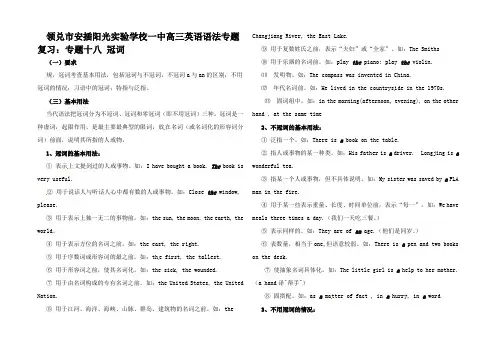
领兑市安插阳光实验学校一中高三英语语法专题复习:专题十八冠词(一)要求规,冠词考查基本用法,包括冠词与不冠词,不冠词a与an的区别;不用冠词的情况;习语中的冠词;特指与泛指。
(三)基本用法当代语法把冠词分为不冠词、冠词和零冠词(即不用冠词)三种。
冠词是一种虚词,起限作用,是最主要最典型的限词,放在名词(或名词化的形容词分词)前面,说明其所指的人或物。
1、冠词的基本用法:① 表示上文提到过的人或事物。
如:I have bought a book. The book is very useful.② 用于说话人与听话人心中都有数的人或事物。
如:Close the window, please.③ 用于表示上独一无二的事物前。
如:the sun, the moon, the earth, the world。
④ 用于表示方位的名词之前。
如:the east, the right.⑤ 用于序数词或形容词的最之前。
如:th e first, the tallest.⑥ 用于形容词之前,使其名词化。
如:the sick, the wounded.⑦ 用于由名词构成的专有名词之前。
如:the United States, the United Nation.⑧ 用于江河、海洋、海峡、山脉、群岛、建筑物的名词之前。
如:the Changjiang River, the East Lake.⑨ 用于复数姓氏之前,表示“夫妇”或“全家”。
如:The Smiths⑩ 用于乐器的名词前。
如:play the piano; play the violin.⑾发明物。
如:The compass was invented in China.⑿年代名词前。
如:He lived in the countryside in the 1970s.⒀固词组中。
如:in the morning(afternoon, evening), on the other hand , at the same time2、不冠词的基本用法:① 泛指一个。
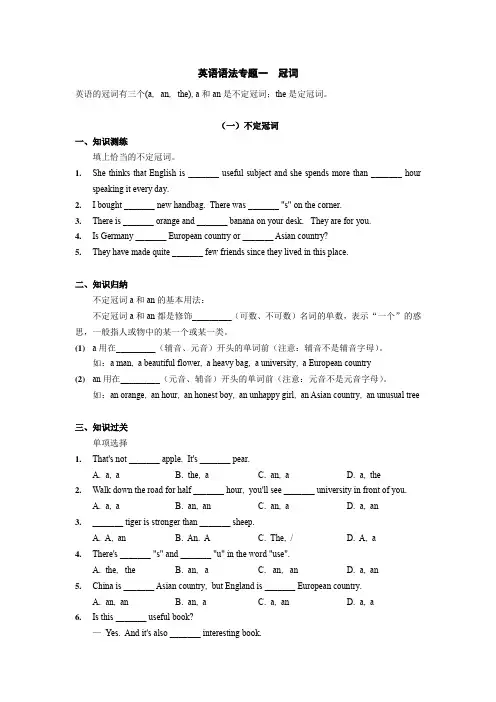
英语语法专题一冠词英语的冠词有三个(a, an, the),a和an是不定冠词;the是定冠词。
(一)不定冠词一、知识测练填上恰当的不定冠词。
1.She thinks that English is _______ useful subject and she spends more than _______ hourspeaking it every day.2.I bought _______ new handbag. There was _______ "s" on the corner.3.There is _______ orange and _______ banana on your desk. They are for you.4.Is Germany _______ European country or _______ Asian country?5.They have made quite _______ few friends since they lived in this place.二、知识归纳不定冠词a和an的基本用法:不定冠词a和an都是修饰_________(可数、不可数)名词的单数,表示“一个”的惑思,一般指人或物中的某一个或某一类。
(1)a用在_________(辅音、元音)开头的单词前(注意:辅音不是辅音字母)。
如:a man, a beautiful flower, a heavy bag, a university, a European country(2)an用在_________(元音、辅音)开头的单词前(注意:元音不是元音字母)。
如:an orange, an hour, an honest boy, an unhappy girl, an Asian country, an unusual tree三、知识过关单项选择1.That's not _______ apple. It's _______ pear.A. a, aB. the, aC. an, aD. a, the2.Walk down the road for half _______ hour, you'll see _______ university in front of you.A. a, aB. an, anC. an, aD. a, an3._______ tiger is stronger than _______ sheep.A. A, anB. An. AC. The, /D. A, a4.There's _______ "s" and _______ "u" in the word "use".A. the, theB. an, aC. an, anD. a, an5.China is _______ Asian country, but England is _______ European country.A. an, anB. an, aC. a, anD. a, a6.Is this _______ useful book?—Yes. And it's also _______ interesting book.A. a, aB. a, anC. an, aD. an, an7.I looked down and saw _______ policeman and an old lady, one of David's neighbours.A. aB. theC. anD. 不填8.How far is it from our school to _______ seaside?It is _______ eight-kilometre walk from here.A. the, anB. /, anC. the, aD. /, a(二)定冠词一、知识测练在需要的地方填上定冠词。
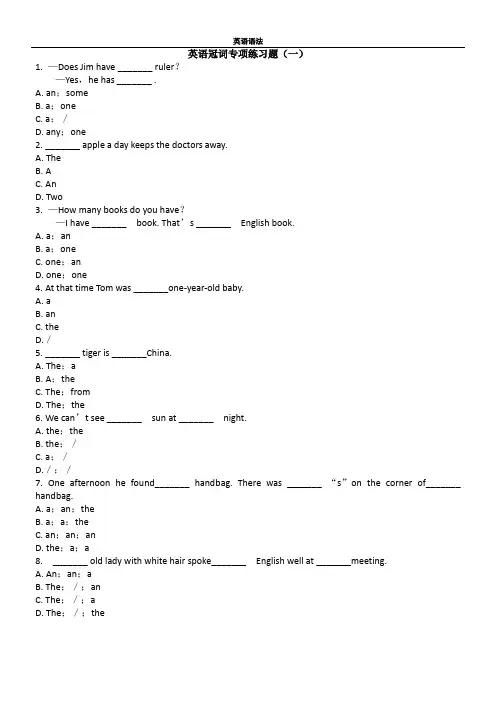
英语冠词专项练习题(一)1. —Does Jim have _______ ruler?—Yes,he has _______ .A. an;someB. a;oneC. a;/D. any;one2. _______ apple a day keeps the doctors away.A. TheB. AC. AnD. Two3. —How many books do you have?—I have _______ book. That’s _______ English book.A. a;anB. a;oneC. one;anD. one;one4. At that time Tom was _______one-year-old baby.A. aB. anC. theD./5. _______ tiger is _______China.A. The;aB. A;theC. The;fromD. The;the6. We can’t see _______ sun at _______ night.A. the;theB. the;/C. a;/D./;/7. One afternoon he found_______ handbag. There was _______ “s”on the corner of_______ handbag.A. a;an;theB. a;a;theC. an;an;anD. the;a;a8. _______ old lady with white hair spoke_______ English well at _______meeting.A. An;an;aB. The;/;anC. The;/;aD. The;/;the9. _______ Great Wall is _______ longest wall in the world.A. A;aB. The;theC. A;theD. The;a10. _______ new bridge has been built over _______ Huangpu River.A. The;aB. A;/C. A;theD. An;the11. _______ woman over there is _______ popular teacher in our school.A. A;anB. The;aC. The;theD. A;the12. He used to be _______ teacher but later he turned _______ writer.A. a;aB. a;theC./;aD. a;/13. Does Tom often play _______football after _______ school?A. /;/B. /;theC. the;/D. a;/14. They passed our school_______ day before yesterday.A. anB. oneC. aD. the15. She has _______ orange skirt. _______ skirt is nice.A. a;TheB. an;TheC. an;AD. the;The16. This is _______ apple. It’s _______ big apple.A. an;aB. a;theC. a;anD. an;the17. Shanghai is in _______ east of China.A. /B. anC. aD. the18. I’ve been a student there for nearly two and _______ half years.A. aB. anC. theD. /19. The museum is quite far. It will take you half _______ hour to get there by _______ bus.A. an;/B. an;aC. a;/D./;/英语冠词专项练习题(一)答案及详解1. —Does Jim have _______ ruler?—Yes,he has _______ .A. an;someB. a;oneC. a;/D. any;one答案: B 第一空是泛指;第二空的one是不定代词,用以替代前面的ruler。
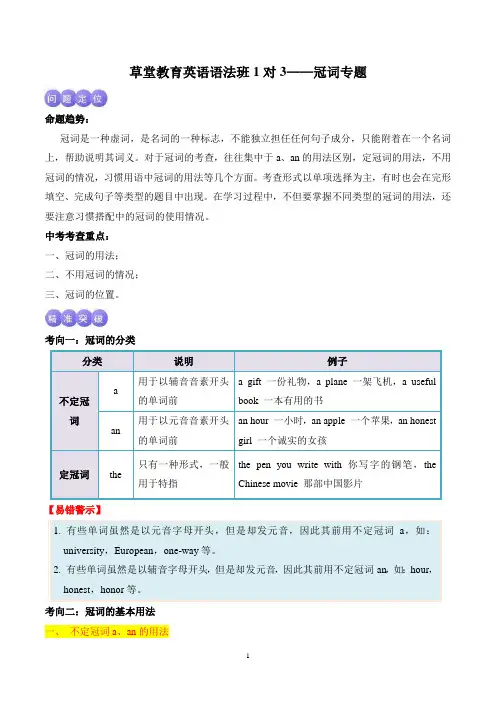
草堂教育英语语法班1对3——冠词专题命题趋势:冠词是一种虚词,是名词的一种标志,不能独立担任任何句子成分,只能附着在一个名词上,帮助说明其词义。
对于冠词的考查,往往集中于a、an的用法区别,定冠词的用法,不用冠词的情况,习惯用语中冠词的用法等几个方面。
考查形式以单项选择为主,有时也会在完形填空、完成句子等类型的题目中出现。
在学习过程中,不但要掌握不同类型的冠词的用法,还要注意习惯搭配中的冠词的使用情况。
中考考查重点:一、冠词的用法;二、不用冠词的情况;三、冠词的位置。
考向一:冠词的分类分类说明例子不定冠词a用于以辅音音素开头的单词前a gift 一份礼物,a plane 一架飞机,a usefulbook 一本有用的书an用于以元音音素开头的单词前an hour 一小时,an apple 一个苹果,an honestgirl 一个诚实的女孩定冠词the 只有一种形式,一般用于特指the pen you write with 你写字的钢笔,theChinese movie 那部中国影片【易错警示】1. 有些单词虽然是以元音字母开头,但是却发元音,因此其前用不定冠词a,如:university,European,one-way等。
2. 有些单词虽然是以辅音字母开头,但是却发元音,因此其前用不定冠词an,如:hour,honest,honor等。
考向二:冠词的基本用法一、不定冠词a、an的用法1. a和an都用于可数名词单数前,泛指人和物。
表示可数事物中的一个。
但两者用法有区别:(1)若随后的单词以辅音音素开头,用a。
如:a lot of,a good idea,a pear。
(2)若随后的单词以元音音素开头,用an。
如:an example,an orange,an apple。
注意:某些以元音字母开头的单词用a,因为其第一个音是/j/。
如:a university,a European language。
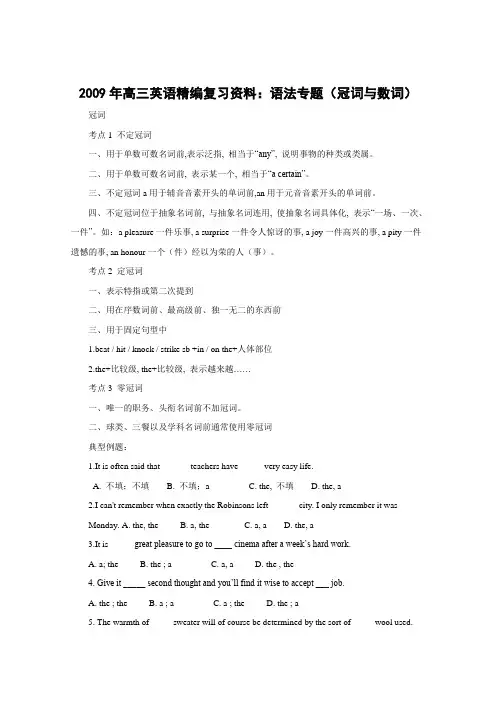
2009年高三英语精编复习资料:语法专题(冠词与数词)冠词考点1 不定冠词一、用于单数可数名词前,表示泛指, 相当于“any”, 说明事物的种类或类属。
二、用于单数可数名词前, 表示某一个, 相当于“a certain”。
三、不定冠词a用于辅音音素开头的单词前,an用于元音音素开头的单词前。
四、不定冠词位于抽象名词前, 与抽象名词连用, 使抽象名词具体化, 表示“一场、一次、一件”。
如:a pleasure一件乐事, a surprise一件令人惊讶的事, a joy一件高兴的事, a pity一件遗憾的事, an honour一个(件)经以为荣的人(事)。
考点2 定冠词一、表示特指或第二次提到二、用在序数词前、最高级前、独一无二的东西前三、用于固定句型中1.beat / hit / knock / strike sb +in / on the+人体部位2.the+比较级, the+比较级, 表示越来越……考点3 零冠词一、唯一的职务、头衔名词前不加冠词。
二、球类、三餐以及学科名词前通常使用零冠词典型例题:1.It is often said that ______ teachers have _____ very easy life.A. 不填;不填B. 不填;aC. the, 不填D. the, a2.I can't remember when exactly the Robinsons left ______ city. I only remember it was____Monday. A. the, the B. a, the C. a, a D. the, a3.It is _____ great pleasure to go to ____ cinema after a week’s hard work.A. a; theB. the ; aC. a, aD. the , the4. Give it _____ second thought and you’ll find it wise to accept ___ job.A. the ; theB. a ; aC. a ; theD. the ; a5. The warmth of _____sweater will of course be determined by the sort of _____wool used.A.The ; theB.the ; /C./; theD./; /6. When I told him he had to be paid by ____ hour, he become angry and hit me on _____nose.A. an; myB. the ; theC. an ;theD. / ;a7. Lincoln was elected ____ President of ____ United States in 1860.A. the ; theB. / ; theC. a; /D. /;/答案:1. 提示:这里的a very easy life(简单的生活)表示泛指。
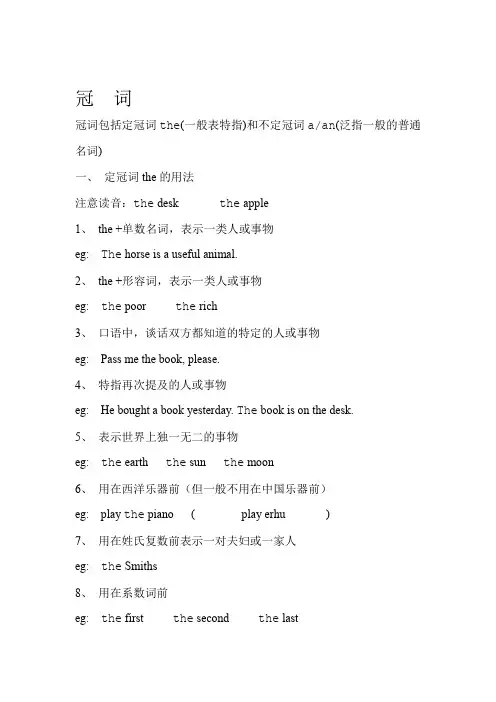
冠词冠词包括定冠词the(一般表特指)和不定冠词a/an(泛指一般的普通名词)一、定冠词the的用法注意读音:the desk the apple1、the +单数名词,表示一类人或事物eg: The horse is a useful animal.2、the +形容词,表示一类人或事物eg: the poor the rich3、口语中,谈话双方都知道的特定的人或事物eg: Pass me the book, please.4、特指再次提及的人或事物eg: He bought a book yesterday. The book is on the desk.5、表示世界上独一无二的事物eg: the earth the sun the moon6、用在西洋乐器前(但一般不用在中国乐器前)eg: play the piano ( play erhu )7、用在姓氏复数前表示一对夫妇或一家人eg: the Smiths8、用在系数词前eg: the first the second the last9、用在形容词或副词的最高级前eg: the oldest the fastest the coldest注意区分下面两句话:most beautiful.the It'sIt's most(very) beautiful.另外当两个形容词或副词的最高级并列修饰同一名词时,后一个最高级前the可省略He is the tallest and (the) fastest in our class.10、用在方位词和某些表示时间的词组或习惯用语前eg: on the left/right in the east in the middle ofin the end in the morning/afternoon/eveningin the daytime on the other hand11、表示在世纪的某个年代eg: in the 1990's in the 1870s12、用在表示单位的名词前eg: by the hour/day/week/month/yearby the yard(码)/foot(英尺)Eggs are sold by the dozen.(注意比较:Eggs are sold by weight.)13、在某些专有名词前eg: the Summer Palace the Red Seathe New York Times the Bible14、用在表示身体部位的名词前eg: He gave me a pat(拍) on the shoulder.二、不定冠词a/an的用法注意使用:a bag an applean hour a useful box an unusual day1、a/an + 单数名词,表示一类人或事物) animal.狡猾的fox is a cunning(A eg:2、表示一个人或事物,起介绍作用eg: He is a doctor.3、说明事物的同一性质、特征、程度或大小= the sameeg: The two shirts are of a size.Birds of a feather flock together.4、用在表示时间或度量单位的名词前,具有“每一”的意思= per eg: 60 miles an hour 1000 yuan a month5、用于人名前,表示说话人对此人不认识,也可以表示与某一名人有类似性质的人或事物eg: A Mr. Smith(一个叫史密斯先生的人)came to see you this morning.He is a LeiFeng in our class.He wishes to become a Newton.三、零冠词的使用1、复数名词表示一类人或事物eg: Cows are useful animals.2、在表示人名、地名、国名、季节、月份、星期几以及节日的名词前eg: Tom Fujian China Spring May Sunday National Day但以festival表达的节日则要使用冠词eg: the Spring Festival3、一日三餐及球类前eg: have breakfast play basketball4、表示学科、棋类、颜色和感官名词前eg: maths play chess White is a beautiful colour.Smell is one of the five senses.称呼语或表示身份、职位、头衔的名词前、5.eg: Good morning, boys and girls. Where is Dad, Mum?Uncle Wang President Lincoln6、物质名词和抽象名词前eg: Desks are made of wood. Failure is the mother of success.7、与by连用的表示交通工具的名词前eg: by bike by bus by sea/land/air但如果换成其它表达就要使用冠词eg: in a boat on the bus take a taxi8、名词前有名词所有格、形容词性物主代词、指示代词、疑问词以及某些形容词(some/ any/ many/ much / little/ a little/few/ a few / each/ every/ either/ another/ both/ all/ no等)作定语时eg: Whose purse is this?9、以and连接的两个相对的名词并用时eg: day and night pen and ink husband and wife father and son master and servant(仆人) heart and soul brother and sister 10、某些介词连接的两个相对的名词时也不用冠词eg: face to face hand in hand step by step side by sidefrom top to bottom from beginning to end11、用as引导的让步状语从句,作为表语的名词提前且为单数时使用零冠词eg: Child as he is, he can answer this question.四、使用冠词与不使用冠词的差异eg: in hospital住院/in the hospital在医院at school/at the school in church作礼拜/in the church by sea乘船/by the sea未来/in the future从今以后in future in front of/in the front ofout of question毫无疑问;没问题/out of the question不可能五、使用定冠词与使用不定冠词的差异eg: the most important meeting /a most important meetingthe third time第三次/a third time第三次+又(再)一次in the distance在远处/at a distance稍远一些for the moment目前;暂时/for a moment一会儿a number of许多/the number of………的数量六、两个或多个名词并列使用时的差异两个或多个名词并列使用时,若指一个人或事物,则在第一个名词前加冠词,若指两个或多个不同的人或事物,则每个名词前都要加冠词。
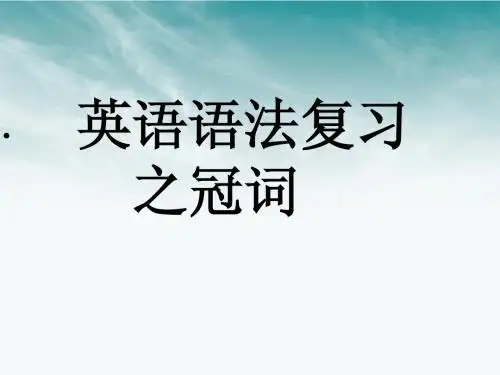
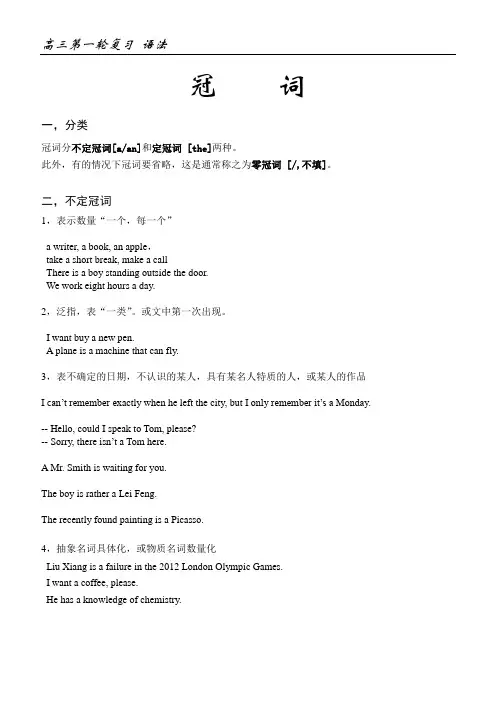
冠词一,分类冠词分不定冠词[a/an]和定冠词 [the]两种。
此外,有的情况下冠词要省略,这是通常称之为零冠词 [/,不填]。
二,不定冠词1,表示数量“一个,每一个”a writer, a book, an apple,take a short break, make a callThere is a boy standing outside the door.We work eight hours a day.2,泛指,表“一类”。
或文中第一次出现。
I want buy a new pen.A plane is a machine that can fly.3,表不确定的日期,不认识的某人,具有某名人特质的人,或某人的作品I can’t remember ex actly when he left the city, but I only remember it’s a Monday. -- Hello, could I speak to Tom, please?-- Sorry, there isn’t a Tom here.A Mr. Smith is waiting for you.The boy is rather a Lei Feng.The recently found painting is a Picasso.4,抽象名词具体化,或物质名词数量化Liu Xiang is a failure in the 2012 London Olympic Games.I want a coffee, please.He has a knowledge of chemistry.5.当世界上独一无二的事物,或专有名词,前或后有修饰成分,那么用a It’s said that there is a rabbit on the moon.The boy painted a green and a red sun on the wall.Einstein is the cleverest man in the world.We want to build a new world, a world where there are no wars.Tom is born in Jinzhou.The youth are working hard in order to build a new Jinzhou.6.当序数词表泛指,翻译为“又一、再一”时,用a试比较:The book is worth reading a second time.This is the second time that I read the book.The first impression of Tom on me is that he is a clever boy.You never have a second chance to make a first impression on others.She learns French as a second language.7. 当最高级没有限定范围,翻译为“非常”时,用aThis is a most interesting movie.This is the most interesting movie that I have ever seen.You are a most famous star.You are the most famous star around the world.5,在of + a +名词结构中,表“同一个”,等于the sameThe two boys are of an age.The two boys are of the same age.These umbrellas are of a color and size.These umbrellas are of the same color and size6,位置问题,so/how/too + adj. + a + n.such/what + a + adj. + n.too difficult a bookso kind a mansuch a kind manHow clever a girl she is!What a clever boy he is!二,定冠词1,特指,或文中第二次出现。

冠词(a,an,the的用法)一、冠词a和an的基本用法:(1)冠词a和an都用在单数可数名词前面,表示某一类人或事物中的一个,或第一次提到的人或事。
其中以辅音音素开头的名词或者名词词组之前用a,以元音音素开头的名词或者名词词组之前用an。
如:I bought book yesterday.我昨天买了一本书。
I bought interesting book yesterday.昨天我买了一本有趣的书。
注意:a用在辅音音素开头(注意不是辅音字母开头)的单词前,an用在元音音素开头(不是元音字母开头)的单词前。
如:an hour,hour [auə]以:[au]开头,所以用an;a book,book以[b]开头,所以用a.(2)用在固定词组中。
如:a lot of许多 a little 一些have a cold感冒have a good time玩得开心二、定冠词the的用法:1. 用以特指某(些)人或某(些)事物,如:This is the house where Luxun once lived. 这是鲁迅曾经住过的房子。
2. 用于指谈话双方都明确所指的人或事物,如:Open the door, please. 请把门打开。
3. 用以复述上文提过的人或事物(第一次提到用“a或an”,以后再次提到用“the”),如:Once there lived a lion in the forest. Every day the lion asked small animals to look for food for him.从前森林里住着一只狮子。
每天这只狮子要小动物们为他寻找食物。
4. 用在序数词和形容词最高级前,如:January is the first month of the year. 一月份是一年当中的第一个月。
Shanghai is the biggest city in China.上海是中国最大的城市。
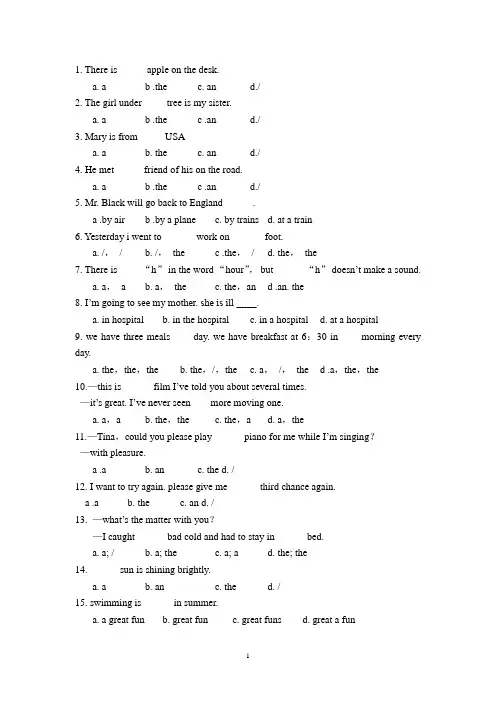
1. There is _____ apple on the desk.a. a b .the c. an d./2. The girl under ____ tree is my sister.a. a b .the c .an d./3. Mary is from _____USAa. ab. thec. and./4. He met _____ friend of his on the road.a. a b .the c .an d./5. Mr. Black will go back to England______.a .by airb .by a plane c. by trains d. at a train6. Yesterday i went to ______ work on ______ foot.a. /,/b. /,the c .the,/ d. the,the7. There is _____“h”in the word “hour”,but______ “h”doesn’t make a sound.a. a,ab. a,thec. the,an d .an. the8. I’m going to see my mother. she is ill ____.a. in hospitalb. in the hospitalc. in a hospitald. at a hospital9. we have three meals ____day. we have breakfast at 6:30 in ____morning every day.a. the,the,theb. the,/,thec. a,/,the d .a,the,the10.—this is______ film I’ve told you about several times.—it’s great. I’ve never seen ___ more moving one.a. a,ab. the,thec. the,ad. a,the11.—Tina,could you please play______ piano for me while I’m singing?—with pleasure.a .a b. an c. the d. /12. I want to try again. please give me______ third chance again.a .a b. the c. an d. /13. —what’s the matter with you?—I caught______ bad cold and had to stay in______ bed.a. a; /b. a; thec. a; ad. the; the14.______ sun is shining brightly.a. ab. anc. thed. /15. swimming is______ in summer.a. a great funb. great func. great funsd. great a fun1-5cbbaa6-10adacc11-15caacb1. Mr Wang has worked as ______ English teacher for more than 10 years.A. /B. aC. anD. the2、. ----How long does it take us to go to your hometown from here?----It takes us hour or more to go to my hometown by train.A. an; aB. a ; anC. an; /D. a; /3、.—What useful book it is!—Yeah, it tells you how to play guitar.A. an;theB. a; aC. a;theD. an; a4、.Susan joined an art club at ___age of six and paints well.A. theB. anC.a5、My uncle is ________ engineer. He works very hard.A. theB. aC. an6、.A horse is _______ useful animal.A. aB. anC. theD. /7、We usually go to ______ school on weekdays, and sometimes go to______ cinema at weekends.A. 不填;theB. the; theC. the; 不填D. 不填;不填8.、_ are planning to go on vacation.A. Black’sB. A Black’sC. The Black’sD. The Blacks9、Mrs Smith has _____ son and a daughter.A. aB. anC. the10、Her daughter began to pla y _____ piano when she was fi ve. Now she’s very good at it.A. anB. aC. theD. /11、. She learned to play piano all by herself.A. aB. anC. theD.不填12、. —What do you want to be in the future, Nick?—I want to be _____ pilot. It is_____ exciting job.A、a; a B. a; an C. the; an D, a; the13、There is ______big supermarket in ______center of our city.A、a; the B. the; a C. the; the14、Beijing, _______ capital of China, has _______ long history.A. a; aB. the; 不填C. the; aD. 不填;the15、Let’s have ____ break; I want to make_______ telephone call.A. a; aB. a; theC. the; aD. the; the16、. "Cindy, do you have ________e-mail address? I want to send you some pho tos. ""Yes, I do. It’s cindy]26@ sohu. com. "A. aB. anC. the17、It is ________ popular way among the young people to chat on the Internet now.A. aB. anC. the18、. —Do you know ______ girl who is standing under ____ tree?—Of course! She is Lucy, my classmates.A. the, theB. a, aC. a, /D. /, the19、There is _____ pencil on the desk.A、an B. a C. the D. /20、I often go to school ________.A. by busB. by a busC. by the bus21、. Sam wants to be _________ actor.A. aB. theC. an22、—Why do you like Jack? —Because he is honest boy.A. aB. anC. the23、I don’t know the city. Where can I find ___good restaurant?.A. aB. anC. theD. (不填)24、Learning_____ country’s language is a better way knowing _____culture behind it.A. the; aB. a; theC. /; theD. a; /25、John can play _____ guitar, but he can’t play ______ chess.A. the;/B./;theC. the; the26、—lily is coming by_____ plane tomorrow.—Let s go to _ airport to meet her.A. a; aB. /; aC. the; theD. /; the27、—What ________ exciting sports show!—Yeah, I love this game.A. aB. theC. an28、.Miss Liu wants to lose weight. She just has _______ cup of milk for _____ ___ breakfast every day.A. a; theB. a;(不填) C. the; a D. the;(不填)29、._______ lion is a dangerous animal. Don’t you think so?A. AB. AnC. The30、. There is big supermarket in center of our city.A. a; theB. the; aC.the; the31、Li Na plays ________ tennis very well. She has become ____first Asian woma n to reach a Grand Slam(大满贯) final.A. a, theB. /, theC. the, aD./,a32、.Meimei’s father is teacher in a school.A. /B. anC. aD. the33、. On April 12, 1961,_____27—year—old Yuri Gagarin(尤里.加加林)became the first human to go into_____ space.A. the;不填B. the; theC. a;不填 D. a; the34、. ---How was ________ dinner at Mike’s house?---It was great. Mike’s mum is _________ wonderful cook.A. a; theB. the; aC. the; theD. a; an35、—Did you get there by ______ bike?—No, I took ______ taxi.A. a; aB. 不填; a C. the; the D. a; the36—What does Michael look like?—He has big eyes and _______ wide mouth.A. aB. anC. the37、. Which of the following phonetic transcription(音标) is right for the phrase “the egg”?eg/ di eg/ D. / eg/ C. /θi A./ðəeg/B. /ði38、My mother is _______English teacher in No. 2 Middle School.A. aB. theC. an D, /39、Look! There is ________ cat in the tree.A. aB. anC. theD. /A. aB. anC. theD.不填41、–By the end of this year, China’s state and provincial (省的) libraries will be free to the public.–That’s_______ good news for those who often go to these places.A. aB. theC. 不填42、. -What are you going to be when you grow up?-teacher like you.A. AB. AnC. TheD./43、. On March 11, 2011 _____ earthquake hit Japan.A. anB. aC. \D. the44、. There’s______ apple on the table. _______ apple is for my little brothe r.A. a; AnB. an; AnC. the; AnD. an; The45、The evening party was really fun. We had _________ great time.A. aB. anC. the D.不填46、Photography can be ______excellent hobby for kids.A. /B. aC. anD. the47、–What do you usually have for ______ breakfast, Peter?–A friend egg, three pieces of bread and a glass of milk.A. aB. anC. theD. /48、.There is _______report in today’s newspaper. It’s about _______sports meeting that will be held in Weihai.A. a; theB. an; theC. the; theD. a; a49、. —Who’s that lovely girl?—You mean ______ girl with long hair? That’s Kate.A. aB. anC. theD. 不填50、My birthday is coming. Dale will send me ___ e - dog as my birthday pre sent.A. aB. anC. the51、. Lily is ______ active girl and she is fond of playing ______ volleyball.A. an; aB. a; theC. an; /D. a; /52、Lady Gaga is ¬¬________very popular singer. She has lots of fans.A. aB. anC. theD. /53、I am going to make ________special house for my pet pig this weekend.A. anB. aC. the54、—Have you seen______ pen? I left one here this morning.—Is it___________ black one? I think I saw it somewhere.A. the; theB. a; aC. the; aD. a; the55、.Lucy is__ good girl. She often helps others.A.aB.anC.theD./56、Justin Bieber is ______Canadian singer and he has lots of fans.A. aB. anC. theD. 不填57、--Do you know ______ man in blue?--Yes, he’s a professor of_________ university.A. the, aB. a, anC. the, anD. / , the58、.—There’s______ ball on the ground. Would you please pass ______ ball to me?—With pleasure.A. the; theB. the; aC. a; aD. a; the59、. Ge You is ______ interesting actor. He has lots of fans.A. aB. 不填C. an60、It’s not __ good idea to drive for four hours without _ break.A. a; aB. a: theC. the; aD. the; the61、As we know, England is _______European country and Singapore is ______Asian country.A. an; anB. an; a C .a; aD. a; an62、. ---Who’s___________ boy in red, do you know?---Oh. He’s___________ friend of Tom.A. the, aB. an, theC. a, theD. the, an63、. —Look at _______ skirt. I bought it for Mother on Mothers’Day, isn’t it nice?—Oh, what _______ nice present!A. a; aB. a; theC. the; aD. a; 不填64、I really like ______ book you lent me yesterday.A. aB. anC. theD. 不填65、. Fred plays _____ piano after _____ supper every day.A. the; theB. /; theC. the; /66、. –Can I help you, sir?-- I’d like to have 100 _____. I want my students to draw pictures.A. piece of paperB. pieces of paperC. pieces of papers67、. This novel can make you laugh and cry at _____ same time.A) a B) an C) the D) /68、We will see __________ even stronger China in __________ near future.A. a; theB. an; theC. the; aD. an; a69、We should often help _______poor.A. aB. 不填C. the70、. I usually go to school on ________foot.A a B. the C. /71、Yao Ming, NBA star, will continue matches this season.冠词1. Mr Wang has worked as ______ English teacher for more than 10 years.A. /B. aC. anD. the答案:C【解析】考查冠词。
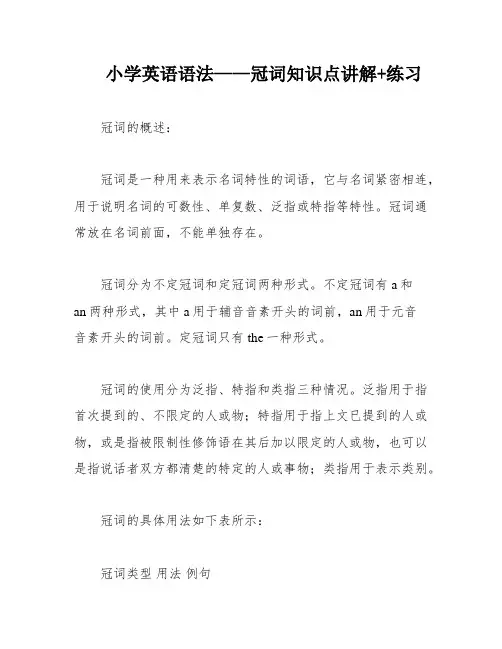
小学英语语法——冠词知识点讲解+练习冠词的概述:冠词是一种用来表示名词特性的词语,它与名词紧密相连,用于说明名词的可数性、单复数、泛指或特指等特性。
冠词通常放在名词前面,不能单独存在。
冠词分为不定冠词和定冠词两种形式。
不定冠词有a和an两种形式,其中a用于辅音音素开头的词前,an用于元音音素开头的词前。
定冠词只有the一种形式。
冠词的使用分为泛指、特指和类指三种情况。
泛指用于指首次提到的、不限定的人或物;特指用于指上文已提到的人或物,或是指被限制性修饰语在其后加以限定的人或物,也可以是指说话者双方都清楚的特定的人或事物;类指用于表示类别。
冠词的具体用法如下表所示:冠词类型用法例句不定冠词泛指单一、每一、任一事物 a(n) A book is on the table。
类指类别 A XXX can fly。
定冠词上文提到过的人或事物 The boy is in the classroom。
特指被限制性修饰语所限定的人或事物 XXX。
说话双方都清楚的人或事物 XXX。
世上独一无二的事物 XXX。
类指类别 XXX。
零冠词名词前泛指人或事物 Cats are cute。
类指类别 XXX。
冠词考点纵览:冠词的考点主要包括不定冠词a/an的用法、泛指和特指的区别、类指的使用等。
具体例题如下:考点一:不定冠词a/an的用法1) This is a book。
这是一本书。
2) There is a boy in the classroom。
教室里有一个男孩。
3) That XXX。
那是一个书包。
考点二:泛指人或事物的某一类别,以区别于其他种类。
1) A plane is a machine that can fly。
飞机是一种能飞的机器。
2) A tiger XXX 老虎可能会很危险。
3) A horse is XXX。
马对人类有用。
考点三:泛指某人或某物。
1) A girl is waiting for you。
以下是为⼤家整理的关于《英语语法⼤全:冠词》⽂章,供⼤家学习参考!⼩编推荐:| | | | | 1、不定冠词a, an a⽤在辅⾳⾳素开头的词前 eg. a book, a useful book an⽤于元⾳开头的词前. eg. an apple, an hour 2、定冠词the 1)特指某⼈/某物 The book on the desk is mine. 2)世上独⼀⽆⼆的事物前 the sun , the moon, the earth, the sky 3)形、副级及序数词前 The third boy is the tallest of all. 注意: He is my first English teacher. 4)the + 姓的复数表⽰ “某家⼈”或“某夫妇”。
the Greens 格林⼀家/ 格林夫妇 3、不⽤冠词的⼏种情况: 1)在星期、⽉份、季节前不⽤冠词 2)学科名词前 3)球类运动及早、中、晚三餐名词前(但:①当三餐名词前有修饰词时,则要加适当的冠词. ②表乐曲演奏的名词前应加the) 1) He went to school after he had a quick breakfast. 2) play the violin / piano 在有些词组中,⽤冠词和不⽤冠词意思有较⼤区别。
in hospital(在住院);in the hospital(在医院) in prison( );in the prison( ) at table(吃饭,⽤餐);at the table(在桌旁) in front of(在某个范围之外的前⾯);in the front of(在某个范围之外的前⾯) go to college(上⼤学);go to the college(去那所⼤学) take place(发⽣);take the place(代替) 练习 ( )1.There is ____ “s” in ____ word “bus”.A. a ; aB. an ; theC. a ; theD. an ; a ( )2.Maths is ___ useful subject. You can’t drop it , I think.A. anB. aC. theD. / ( )3.____ bad weather it is!A. HowB. What aC. How aD. What ( )4.—What color is ___ orange? --It’s _____ orange.A. an; anB. an ; theC. an ; /D. / ; an ( )5.Mr. Li is ____ old worker.A. anB. aC. someD. / ( )6.Look at ____ picture! There’s ____ house in it.A. a ; aB. the ; theC. a ; theD. the; a ( )7.One morning he found ____ handbag. There was ___ “s” on the corner of ___ handbag.A. a ; an ; theB. a ; a ; theC. a ; a ; aD. the ; an ; a ( )8.What ___ interesting story it is!A. aB. anC. theD. / ( )9.Meimei is ___ best student in her class.A. aB. anC. /D. the ( )10.Tom is ___ kind boy. All ___ students love him.A. a ; /B. a ; theC. an ; /D. an ; the ( )11.Is ___ book on the desk mine? Yes.A. theB. aC. anD. / ( )12.Even while he was in ___ hospital, he went on writing songs.A. aB. anC. theD. / ( )13.Don’t read _____.A. in bedB. in the bedC. on bedD. on the bed ( )14.Smith is ____ honest man.A. aB. theC. anD. / ( )15.China has ___ population of 1,200,000,000.A. /B. anC. theD. a ( )16.What’s ____ for “椅.⼦”?A. EnglishB. an EnglishC. the EnglishD. any English ( )17.Mary is ___ cleverer of the two girls.A. theB. aC. anD. much ( )18.____ young must look after ___ old.A. The ; aB. The ; theC. A ; aD. A ; the ( )19. ___ earth is one of ____ planets.A. The ; sun’sB. The ; the sunC. The ; the sun’sD. The ; the suns’ ( )20.Tokyo is ___.A. the capital of JapanB. capital of JapanC. Japan capitalD. a capital of Japan ( )21.Kate sometimes plays ___ violin(⼩提琴) and sometimes plays ___ table tennis before supper.A. / ; theB. the ; /C. the ; theD. / ; / ( )22. –Have you seen ___ pencil? I left it here this morning. --Is it ___ red one ? I saw it.A. a ; theB. the ; theC. the ; aD. a ; a ( )23.There is_______ orange tree behind_____ house.A. an ; theB. a ; aC. the ; theD. an ; / ( )24.—How long did you stay there ? --About half ___ hour.A. /B. oneC. aD. an 练习题答案: 1——5 DBDCA 6—10 DABDB 11—15 ADACD 16—20 AABCA 21—24 BDAD。
中考英语语法:冠词的九个考点+五个难点+易错点一、冠词的考点:二、■不定冠词的四个高频考点(1) 用于序数词前:序数词前一般用定冠词,若用不定冠词,则表示“再一”“又一”的意思。
如:We’ll have to do it a second time.我们得再做一次。
When he sat down, a fourth man rose to speak. 他坐下后,又—个站起来发言。
(2) 用于动作名词前:即用于表示动作意义的名词,表示一次、一番等义,此时通常与介词for或动词have, take, make, give 等搭配使用。
如:Let’s go for a walk.咱们出去散散步。
Much interested, he agreed to give it a try. 由于很感兴趣,他同意试一下。
(3) 用于人名前:相当于a certain,意为“一个”“某个”。
如:A Mr. Johnson came to see you while you were out. 你不在时有位叫约翰逊的先生来看你。
(4) 用于抽象名词前:使之具体化,表示与该之相关的具体的人或事。
比较:Hard work is the way to success. 苦干是成功之路。
(success为抽象名词,不可数,其前不能用不定冠词)I’m anxious that the party should be a success.我盼望这次聚会圆满成功。
(success表示“成功的事”,可数,连用不定冠词)■定冠词的五个高频考点定冠词的用法比较复杂,除表示特指外,还可表示独一无二的事物、用于最高级前、用于序数词或方位词之前、用于乐器名词前、用于江河湖海等前等。
这些用法大家一般都比较熟悉,而且在考试中出现的机会也相对较少,下面为同学们归纳的是几条大家易错而且高考比较常考的用法:(1) 用于复数姓氏前:即用于在姓氏的复数形式之前表示一家人或夫妇二人。
英语语法:冠词讲解及练习题(附答案)冠词是一个虚词,它置于名词之前,限定名词的意义.冠词可分为定冠词,不定冠词和零冠词三类。
下面学习啦小编为大家带来冠词语法讲解及练习题,欢迎大家学习!一、冠词语法讲解1. a用于辅音发音开头的词前, 如:a book; an用于元音发音开头的词前,如:an apple, an hour. 请区别:a useful machine, an umbrella, a “u”, an “h”。
2.指上文提到过的人或物,用定冠词the。
3.在世界上独一无二的事物前用定冠词the. 如:the sun, the moon, the earth。
4.the用于序数词,表方位的名词和形容词最高级前。
the first, the best , in the south。
5.在复数姓氏前加the,表示××一家人,常看成复数。
如:the Browns。
6.在介词短语中常用定冠词the,如:in the box ,behind the chair。
7.不能用定冠词the的几个方面: (1)在节日、星期、月份、季节、年等词前不用冠词。
如:in summer, in August 请区别:in the spring of1945. (这里表示特指,故加the)(2)一日三餐和球类运动名不用冠词。
如:have breakfast ,play football(3)一些固定词组中,如:go to bed ,go to school, by bus ,at night. 8.在有些词组中,有冠词和无冠词意思不同,请注意区别:in front of 在…前面, in the front of 在…范围内的前部in hospital (生病)住院, in the hospital 在医院里。
二、练习题1. When Linda was a child,her mother always let her have ______ bed.A. the breakfast inB. the breakfast in theC. breakfast inD. breakfast in the2. Beyond ______ stars the astronaut saw nothing but ______ space.A. the,不填B. 不填,theC. 不填,不填D. the,the3. Alexander Graham Bell invented ________ telephone in 1876.A. 不填B. aC. theD. one4. After watching ____ TV,she played _____ violin for an hour.A. 不填,不填B. the,theC. the,不填D. 不填,the5. Many people are still in ____ habit of writing silly things in ____ public places.A. the,theB. 不填,不填C. the,不填D. 不填,the6. Paper money was in ____ use in China when Marco Polo visited the country in ____ thirteenth century.A. the,不填B. the,theC. 不填,theD. 不填,不填7. Have you seen ______ pen? I left it here this morning.Is it ____ black one? I think I saw it somewhere.A. a,theB. the,theC. the, aD. a, a8. She is _____ newcomer to ____ chemistry but she has already made some important discoveries.A. the,theB. the,不填C. a,不填D. a,the9. Many people agree that ___ knowledge of English is a must in ____ international trade today.A. a,不填B. the,anC. the,theD. 不填,the10. ______ usually go to church every Sunday.A. The BrownB. A BrownC. BrownsD. The Browns11. The train is running fifty miles ______.A. an hourB. one hourC. the hourD. a hour12. ___ earth we live on is bigger than___ moon.A. The, aB. The,theC. An, aD. An,the13. —What’s the matter with you ?—I caught ___ bad cold and had to stay in ___bed.A. a,/B. a,theC. a, aD. the,the14. —Do you know ___ lady in blue?—Yes. She is a teacher of a university.A. theB. aC. anD. /15. —Where’s ___ nearest supermarket?—It’s over there,just around the corner.A. aB. anC. theD. /16. The young man will work in ___ school as a maths teacher.A. theB. aC. anD. /17. Most of the representatives think that ______ the meeting was very successful.A. on whole ofB. on a wholeC. on the wholeD. on the whole that18. The investigators found that more should be done for ______ in India.A. those poorB. a poorC. poorD. the poor19. He grabbed me ______ and pulled me onto the bus.A. a armB. an armC. the armD. by the arm20. “How did you pay the workers?”“As a rule,they are paid ______.”A. by an yourB. by the hourC. by a hourD. by hours21. What _____ exciting football match! Our team beat Tom’s team at last.A. aB. anC. theD. /22. In the United States,Father’s Day falls on _____ third Sunday in _____ June.A. the,不填B. the, aC. 不填,theD. a,不填23. I have two dogs. ______ black one is two years old and ______ yellow one is three years old.A. A, aB. The, aC. The,theD. A. the24. ______ new bridge has been built over ______ Huangpu River.A. The, aB. A,/C. A,theD. An,an25. -What colour is ______ orange?-It’s _____ orange.A. an,anB. an,theC. an,/D. /,an参考答案:1. C2. A。
高考英语语法专题冠词答案:a as a result是固定搭配,意为“结果”,强调某种原因产生的结果。
2.(2017·全国卷Ⅱ,64)This included digging up the road, laying the track and then building a strong roof over ________ top.答案:the此处特指“顶部”,故用定冠词the。
3.(2017·全国卷Ⅲ,62)Instead, she is earning £6,500 a day as ________ model in New York.答案:a句意:相反,她在纽约做模特每天收入6,500英镑。
model是可数名词,在此表示泛指,且读音以辅音音素开头,故用不定冠词a。
4.(2016·全国卷Ⅱ,48)Give your body and brain a rest by stepping outside for ________ while,exercising, or doing something you enjoy.答案:a for a while “一会儿”,固定搭配。
5.(2016·全国卷Ⅱ,短文改错)In that case, we will learn little about ________ world.答案:the句意:那样的话,我们将会对这个世界了解甚少。
world属于表示世上独一无二的事物的名词,其前应用定冠词。
6.(2016·全国卷Ⅰ,阅读A)In 1931, Addams became ________ first American woman to win theNobel Peace Prize.答案:the序数词前面加定冠词the。
7.(2016·浙江高考,2)________ prize for the winner of the competition is________ two-week holiday in Paris.答案:The; a句意:这次比赛的获胜者奖是去巴黎为期两周的休假。
冠词一、不定冠词1.表示相同、同一或具有相同的性质不定冠词的这种用法常与of搭配,构成“of+a/an+名词”,在句中常作表语或后置定语。
●Birds of a feather flock together. 物以类聚。
●We are all of an age. 我们都是同龄人。
2.表示单位量词的“每”常用在指时间、重量、速度、价格等的单位量词前,表示“每一”,相当于per,each,every等。
●Take three pills a day and you’ll get better soon.每天吃三片药,你很快就会好的。
●We have a music class once a week. 我们每周上一次音乐课。
3.用于表示整体的集体名词、可数名词化了的不可数名词及专有名词前●John Smith has a happy family. 约翰有一个幸福的家庭。
●A heavy rain fell yesterday. 昨天下了一场大雨。
4.用于部分动词短语中●have a long history●receive a good education●a knowledge of English and computer5.含有不定冠词的常用短语all of a sudden 突然in a moment 立刻as a rule 通常as a result 因此half an hour 半个小时in a hurry 急匆匆地catch a cold 感冒have a fever 发烧keep an eye on 照看give sb. a hand 给sb.帮忙二、定冠词1. 用在可数名词单数前表示一类人或事物●The brain is the center of thought. 大脑是思维的中心。
●The cat, like the dog, is liked by many people. 猫和狗一样被很多人喜欢。
使用定冠词的场合1.用在表示独一无二或被认为唯一东西的名词前。
(如果这类名词前边有形容词修饰,表示阴晴雨雪等不同的状貌,则可用不定冠词。
)2.用在第二次提到的人或物的名词前。
3.某些表示自然界事物(山脉、潮汐、大海、风、雨、雪、田野等)的名词,即使是泛指,也要用定冠词。
4.用在与先前提及事物存在关联的名词前。
5.用在表示特指(即交谈双方彼此熟知或心照不宣)的人或物的名词(一般为单复数形式的个体名词)前。
6.用在由后置定语(如短语或从句)修饰的(专用)名词前。
7.用在形容词/副词最高级或序数词前。
(部分短语或习语例外,使用零冠词;如 firstcousins, be second to, do sth. first thing, at first glance, on second thoughts, first lady, first secretary 和 first prize 等。
)8.当 only, main, sole, same, following, last, next, opposite, present, usual, wrong,ultimate, right, principle 等修饰名词时,前面用定冠词。
(only son, only daughter, only child 前可用不定冠词,其他此类形容词前偶尔也可用不定冠词。
)9.“定冠词 + 单数名词”结构表示类属(即表示一类人或物)。
英语中表示类属可有三种方式:①不定冠词 + 单数名词;②定冠词 + 单数名词;③复数名词。
但它们的意义有所不同,不定冠词:列举实例(相当于 every/each,“以一概全”);定冠词:对比类别;复数名词:概括全体(相当于 all)。
10.“定冠词 + 复数名词”结构表示某类人的总称,或集体中的任何一个或多于一个(亦可泛指时日)。
11.“定冠词 + 形容词/动名词/过去分词/名词”结构表示同一类人或物,或某种抽象概念(如性质、品质等)。
其中,“定冠词 + 形容词”结构还可以表示“部分”概念。
【参见附录1.1】12.“定冠词 + 姓氏复数”结构表示“一家人”的概念。
13.定冠词和部分名词连用表示民族、阶级或阶层等。
(如 the Chinese, the bourgeoisie, theintellectuals, the upper class 等。
)14.“定冠词 + 普通名词 + of + 抽象名词”结构表示比喻含义。
15.用在人名(可以是名人或普通人)等专有名词前,表示鉴别意义(该人名前往往有普通名词或形容词等修饰性成分,表示其特征、性质或某种感情等),或直接用在(交谈双方共指且作同一理解的)名人的姓名前(中间修饰成分可有可无),起到强调作用。
16.用在乐器名词前。
17.用在表示计量单位的名词前,表示“每一”,往往具有 every, each 或 per 的含义。
(也可用不定冠词。
)18.用在表示方向或方位的名词前。
(某些“方位名词 + 介词”结构例外,如 north by east,from east to west 等。
)(参考“使用零冠词的场合”的第 20 条。
)19.如果方位名词大写,表示某一国家或世界的某一部分时,前面用定冠词。
(参考建议同第 17条。
)20.在 suburbs(郊区)和 countryside(农村)之前用定冠词。
21.用在表示江、河、海、洋、山脉、群岛、海峡、海湾、报刊、杂志、书籍、会议、条约、信仰、学校、星座、飞机、船舶、舰队、铁路、三军、建筑物、都市、宗教事物、历史朝代等的名词前。
【参见附录1.2】22.中国的湖泊名词前常用定冠词。
(一般而言,含有Lake, Mount, Cape 等表示湖泊、独山和孤岛的名词前均不用定冠词,使用零冠词。
)(Ref.P6<②>,实例总结)23.当用人名、地名表示船舶、飞机等的名称时,前面用定冠词(或同时用斜体表示)。
24.相对于中国而言,外来语中的皇帝称号一般需用定冠词。
(中国历史上的皇帝称号用不用皆可。
)25.当专有名词表示:①某人的作品;②某人设计、制造、发明的产品;③某个品牌的产品时,如果泛指“作品”或“产品”,前面通常用定冠词。
(如果特指/暗指“某一个/件/幅/篇/部…作品/产品”,则前面用不定冠词。
特别地,以作者姓名表示其作品时,如果泛指“作品”,通常使用定冠词(少数)或零冠词(多数),如果特指/暗指“某一个/件/幅/篇/部…作品”,前面通常用不定冠词。
)26.一般而言,文艺作品前通常用定冠词。
(以人名作为书名、剧名、电影名时,不用定冠词,使用零冠词。
)(参考“使用零冠词的场合”中第 31 条。
)27.用在表示与人体(如 health<健康>、flesh<躯体>、mind<心灵>、pain<痛苦>、soul<灵魂>等)密切相关的名词前。
另外,在动介搭配(如 struck him in the eye 等)中,定冠词用在与人体典型部位(如腿、脸、前额、眉毛、肋骨等)密切相关的名词前,除此以外,使用零冠词。
对于表示身体部位的单数名词,在“形容词 + of + 名词”结构中,名词前使用零冠词。
28.由普通名词参与构成的专有名词前往往要加定冠词,如某些国家名称或(政治)组织/机构名称。
(例外举例:Congress, Parliament。
另外,表示人名、地名的专有名词前一般不用定冠词,使用零冠词。
)29.当专有名词后接表示身份、职业等的名词(作同位语)时,如果该专有名词表示的人或物为人们所熟悉,则该专有名词前用定冠词。
(如果不熟悉,则用不定冠词。
)30.用在某些具有动词含义(即动词化)的名词前。
(如on thefly/go/increase/run/move/prowl, all the go, to the rescue 等)31.用在逢“十”的复数数词前,表示世纪中的几十年代或人的大约年龄。
(如 in the seventies,in the 50s 和 in the mid-fifties 等。
)32.用在单数名词前,表示该名词的属性、功能或有关的抽象概念等。
(如 to the ear <悦耳>、to the eye <悦目>、the schoolboy <书生气>、the patriot <爱国心>、on the stage <舞台生涯>、the poet <诗性>、fond the bottle <贪杯>、the pen <文学>、the sword <武功> 等)33.定冠词的使用会影响到数的概念:一般而言,在表示特指的情况下,如果两个名词表示两个人或物,通常每个名词前都要用定冠词;如果两个名词表示同一人或物,通常共用一个定冠词。
(在表示强调作用时,或在少数不会误解的情况下,可用一个定冠词表示两个(或多个)不同的人或物。
参考“使用不定冠词的场合”中的第 14 条。
)34.可以使用定冠词加强特指含义(此时定冠词强读,且用斜体表示)。
35.可以使用定冠词表示(明显或暗含的)对比或对照关系。
36.集体名词前常用定冠词,表示“全体成员”这一概括意义。
现举例如下:community, crowd,public, staff, militia, audience, town, village, world, school 等。
37.定冠词可以表示典型意义,其所修饰的人或物是“典型的、真正的、著名的、出色的或符合理想/标准的”。
38.在“数词 + of + 宾语”结构中,如果宾语为名词,则该名词前必须有定冠词或其它限定词。
39.罗列几个并列的名词时,如果前面的若干个名词使用“不定冠词 + 序数词”结构,则最后一个名词前使用“定冠词 + 序数词”结构。
(参考“使用不定冠词的场合”中的第 19 条。
)使用不定冠词的场合1.表示“一”这个数量。
2.用在可数名词前,表示类属(即表示一类人或物)。
(参考“使用定冠词的场合”中的第 8 条。
)3.用在某些数目的表示法中,如 a dozen, a couple, an eighth, a quarter, a great many,twice a week 等。
4.用在姓名前,或“Mr./Mrs./Miss/Ms. + 姓氏”前,表示“某一个,某位”,有不肯定的含义;也可表示“一位”,指某家庭的成员。
5.用在地名、国名等专有名词前,表示某时的情况或某种样子。
6.用在某些物质名词前,表示“一阵、一份、一类、一场”等含义。
7.用在某些表示情绪的抽象名词(常在交谈语境中)或其他抽象名词(常在陈述语境中)前,表示“一种、一类、这种、那种”等含义;还可用在复数抽象名词前,表示某种单一概念(如事物或状态等),或用在表示时间、款项的复数名词前,表示一个整体单位/概念。
8.不定冠词可表示“同一、相同”的含义。
(如 birds of a feather <一丘之貉>,people ofa mind <观点相同的人> 等。
)9.不定冠词可用在“so/as/too/how/however + 形容词 + 不定冠词 + 名词”结构中,表示比较或强调。
在这种结构中,能且仅能用不定冠词。
(如 so cold a day, as clever a girl, too heavy a box, how serious a crime 等。
)10.在“不定冠词 + 名词 + of + 不定冠词 + 名词”结构中,前面的名词表示的是后面的名词的性质或特征,意为“像……一样的,是属于一类的”,在该结构中能且仅能用不定冠词。
(前面的名词可带有修饰性成分,如形容词、物主代词、定冠词、some、this、these、that、those 等,后面的名词为中心词,其可为复数形式,同时前面使用零冠词。
)(“定冠词 + 普通名词 + of + 抽象名词”结构表示比喻含义;而 a bit of a mess, a bit of a shock 等中的对应结构则表示“有点儿……”.)11.当 turn 或 go 作“变成”解时,如果其后的表语名词前有形容词等修饰性成分,则该名词前用不定冠词。
(如果其后的表语名词前没有任何修饰性成分,则不用定冠词/不定冠词,使用零冠词。
)12.“不定冠词 + 专有名词”结构可表示:①与某个专有名词表示的人或物等相仿,即具有相同或相似的性质;②某种状态下的人或物;③某人的作品,或某人设计、制造、发明的产品,或某个品牌的产品(均特指/暗指“某一个/件/幅/篇/部…作品/产品”)。